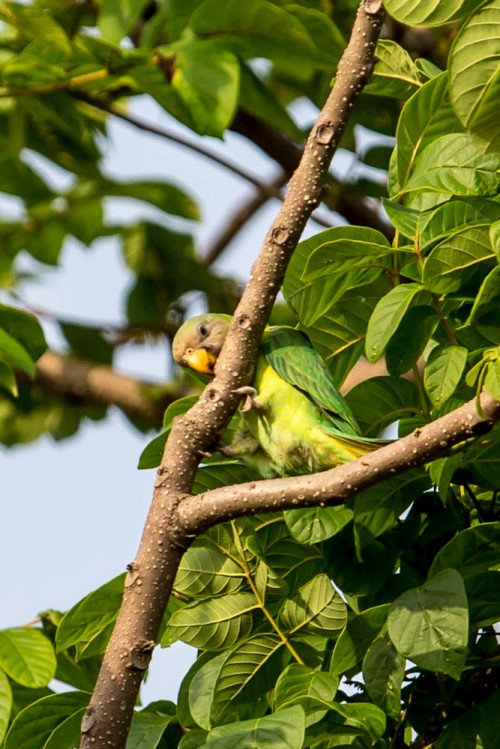
I found this Male Plum-headed Parakeet (Psittacula cyanocephala) along with a juvenile on a tree. It was a bright sunny evening. I was using Canon EOS 5D Mark III with Canon EF 300mm f/2.8L IS USM and a Canon EF 1.4x III Extender. I followed these birds throughout that evening. Adult Male was picking up fruits and feeding the juvenile. It was as though it was training the young one to identify various edible fruits. They were going from a tree to tree and sampling the fruits there. Most of these activity was going on the tree canopy. I was able to capture only few moments clearly when they descended down to lower branches. The magnification required is not enough, so all these photos are cropped from their original to remove the clutter of branches. Because of the superior sensor resolution of 5D Mark III you will not see much of deterioration in the images.

I had earlier photographed Female Plum-headed Parakeet here. Plum-headed Parakeets (Psittacula cyanocephala) are endemic to Sri Lanka and most of India, as well as Rawalpindi in West Pakistan, Nepal east to Bhutan and West Bengal.

Their preferred habitats are the forest areas and open woodland. Populations undergo local movements, driven mainly by the availability of the fruit and blossoms which make up its diet. Though this species is not exploited as heavily for feather and pet trade as the sympatric (of the same geographic region) Alexandrine Parakeet(Psittacula eupatria) the trade do takes its toll on local populations across the range. Population is reduced in urban areas and heavily inhabited zones.

This is a green parakeet, averaging 13 – 14 ins (33 – 35 cm) in length, with the tail accounting for about two thirds of the length. The male’s head is red, becoming purple-blue on the back of the crown, nape and cheeks. There is a narrow black neck collar and a black chin stripe. There is a red shoulder patch and the rump and tail are bluish-green, the latter tipped white. The upper beak is orangish-yellow, and the lower beak is dark.

The female has a grey head, corn-yellow upper beak and lacks the black neck collar, chin stripe and red shoulder patch. Immature birds have a green head and both upper and lower beaks are yellowish. Females attain the adult plumage at 15 months; young males attain full adult male plumage at about 30 months.

The different head color and the white tip to the tail distinguish this species from the similar Blossom-headed Parakeet (Psittacula roseata). The male Plum-headed Parakeet has a darker red head, while the male Blossom-headed Parakeet’s head is pink. The Blossom-headed Parakeets have yellow tail tips, while the Plum-headed Parakeet has white tail tips.

Plum-headed Parakeets usually lay clutches averaging 4 – 6 eggs which they incubate for about 21 – 23 days. The plum-headed parakeets nest in holes in trees. Plum Headed Parakeets produce one clutch a year. The breeding season typically begins in April. The average clutch size is 4 – 6 eggs and the incubation period lasts from 19 to 23 days. The chicks will fledge at about 6 to 7 weeks of age.


Very nice photos of the plum head parakeet! Beautiful!!
Thank you Sandy
Please i need to know about the adult plumage. At what age they start getting there adult plumage.
Dear Dr Shivam jar,
Females attain the adult plumage at 15 months; young males attain full adult male plumage at about 30 months.
Thanks for contacting me